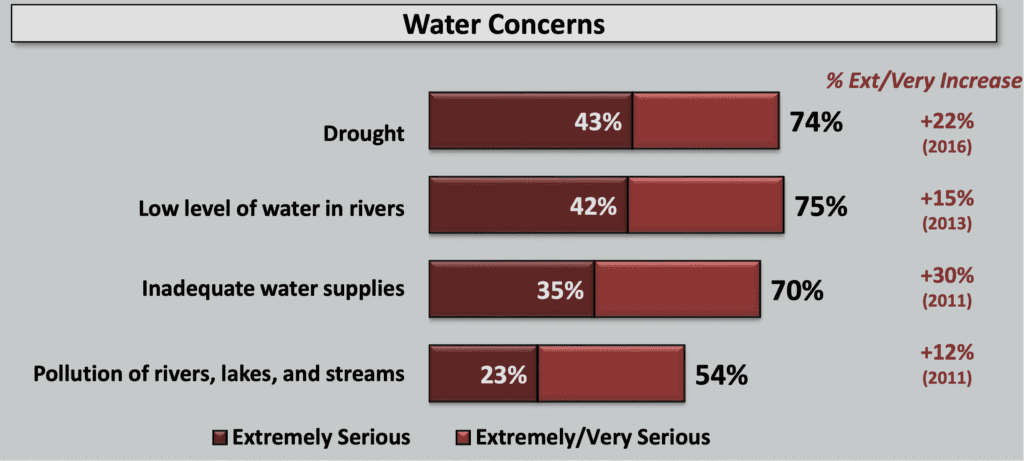Coming up in cause communications, I remember my Resource Media colleague Ben Long saying, “the first rule of strategic communications is to meet people where they are.” Ben is the person that first taught me how to use public opinion polling, which I first encountered as a tool to measure support for specific policy ideas. But there’s so much more we can learn from polling, including the way our issues stack up against other timely topics, the intensity of concern around specific challenges, and the best way to frame solutions.
The Water Hub works with Nexus Polling to conduct water polls every year designed to fill in gaps in existing opinion research (you can check out our past polls here, here, and here). We also study annual polls like Value of Water, State of the Rockies, and PPIC’s Californians and the Environment. If you want to delve more deeply, especially into historic polling, I recommend checking out WaterPolls.org. It was only maintained through 2018, but has a real wealth of information!
Late last month, we offered a Western water polling update for our network, sharing toplines from the recent polls below, as well as two private polls we aren’t able to link to:
- Walton Family Foundation World Water Day poll (March 2022)
- Colorado College State of the Rockies poll (February 2022)
- Thornburg Foundation/Water Foundation New Mexico poll (December 2021)
- Water Hub California drought poll (November 2021)
- Water Hub/Climate Nexus national voter poll (March 2021)

What we know from water polling:
- Public opinion is changeable (look at how climate concerns have grown over time!)
- Media is one of the ingredients in the stew of public opinion: both news and social media can help to elevate issues and build support for solutions.
- TV is the source most voters rely on for water and climate news, so it’s worthwhile to spend time educating and pitching TV journalists.
- Safe drinking water is a bipartisan priority, and voters want the government to do more to prevent pollution, upgrade aging infrastructure, and ensure access for all.
- 86% of voters nationwide say it’s urgent to “provide access to clean, safe drinking water.”
- 87% of Western voters support increased federal funding for rural and tribal water and sanitation.
- Water shortages are a growing concern, especially among Western voters.
- 73% of voters nationwide are concerned about climate-driven water scarcity.
- 75% of Western voters are worried about low levels of water in rivers, and 70% worry about inadequate water supplies (we believe the first number is higher because it’s a more concrete problem, and one people can picture.)
- People want action now to protect existing water supplies and prepare for a drier future.
- Strong majorities like the idea of protecting groundwater as well as rivers, lakes and streams.
- Voters generally prefer the idea of “wiser use and reuse” over “new dams and diversions.”
- Conservation polls extremely well, but voters tend to think of household (versus agricultural or industrial) water savings because that has been the focus of most public education campaigns and policies.
- Most people trust farmers and ranchers to use water responsibly (and few are aware how much water the agricultural sector uses), but there’s strong support for agricultural efficiency programs.
- Voters believe the best solutions work for both people and nature
- Nature-based solutions like restoring floodplains and protecting wetlands poll well. In fact, voters are more likely to indicate support for these specific kinds of projects than for an abstract concept like “natural infrastructure.”
I hope this is helpful. For more detail, you can download our slide deck with more detail here, or watch the hour-long video recording here. And, please don’t hesitate to reach out for help thinking through framing and messaging for your campaigns, based on what we know about public opinion.
For more information and to stay in the loop, sign up for our newsletter, the Water Cooler.